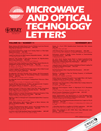Formation of bowtie-shaped excitation in a photonic–microfluidic integrated devices
Abstract
Narrowly confining the beam intensity in a well-defined region in the center of cell flow is a necessary step to perform reliable flow cytometry testing but has so far not been achieved in a photonic–microfluidic integrated device.We were able to focus the excitation beam to a very narrow bowtie shape with a near uniform intensity across the flow stream for excitation for a flow cytometry application. Beam geometry was achieved by integrating a one-dimensional lens system with planar waveguides and a microfluidic channel on one substrate using one patterning material via a one-shot process. This letter reports the method used to achieve such shaped beams and the performance of the shaped beams. © 2011 National Research Council Canada & Wiley Periodicals, Inc. Microwave Opt Technol Lett 53:2583–2586, 2011; View this article online at wileyonlinelibrary.com. DOI 10.1002/mop.26309




